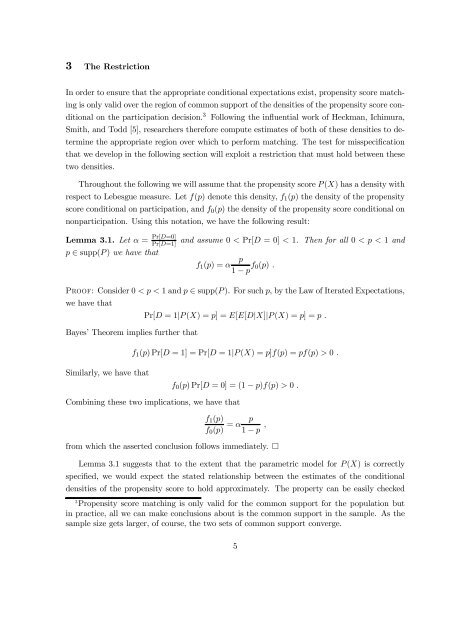On the Identification of Misspecified Propensity Scores - School of ...
On the Identification of Misspecified Propensity Scores - School of ...
On the Identification of Misspecified Propensity Scores - School of ...
Create successful ePaper yourself
Turn your PDF publications into a flip-book with our unique Google optimized e-Paper software.
3 The Restriction<br />
In order to ensure that <strong>the</strong> appropriate conditional expectations exist, propensity score match-<br />
ing is only valid over <strong>the</strong> region <strong>of</strong> common support <strong>of</strong> <strong>the</strong> densities <strong>of</strong> <strong>the</strong> propensity score con-<br />
ditional on <strong>the</strong> participation decision. 3 Following <strong>the</strong> influential work <strong>of</strong> Heckman, Ichimura,<br />
Smith, and Todd [5], researchers <strong>the</strong>refore compute estimates <strong>of</strong> both <strong>of</strong> <strong>the</strong>se densities to de-<br />
termine <strong>the</strong> appropriate region over which to perform matching. The test for misspecification<br />
that we develop in <strong>the</strong> following section will exploit a restriction that must hold between <strong>the</strong>se<br />
two densities.<br />
Throughout <strong>the</strong> following we will assume that <strong>the</strong> propensity score P (X) has a density with<br />
respect to Lebesgue measure. Let f(p) denote this density, f1(p) <strong>the</strong> density <strong>of</strong> <strong>the</strong> propensity<br />
score conditional on participation, and f0(p) <strong>the</strong> density <strong>of</strong> <strong>the</strong> propensity score conditional on<br />
nonparticipation. Using this notation, we have <strong>the</strong> following result:<br />
Lemma 3.1. Let α = Pr[D=0]<br />
Pr[D=1]<br />
p ∈ supp(P ) we have that<br />
and assume 0 < Pr[D = 0] < 1. Then for all 0 < p < 1 and<br />
f1(p) = α p<br />
1 − p f0(p) .<br />
P: Consider 0 < p < 1 and p ∈ supp(P ). For such p, by <strong>the</strong> Law <strong>of</strong> Iterated Expectations,<br />
we have that<br />
Bayes’ Theorem implies fur<strong>the</strong>r that<br />
Similarly, we have that<br />
Pr[D = 1|P (X) = p] = E[E[D|X]|P (X) = p] = p .<br />
f1(p) Pr[D = 1] = Pr[D = 1|P (X) = p]f(p) = pf(p) > 0 .<br />
f0(p) Pr[D = 0] = (1 − p)f(p) > 0 .<br />
Combining <strong>the</strong>se two implications, we have that<br />
f1(p) p<br />
= α<br />
f0(p) 1 − p ,<br />
from which <strong>the</strong> asserted conclusion follows immediately. <br />
Lemma 3.1 suggests that to <strong>the</strong> extent that <strong>the</strong> parametric model for P (X) is correctly<br />
specified, we would expect <strong>the</strong> stated relationship between <strong>the</strong> estimates <strong>of</strong> <strong>the</strong> conditional<br />
densities <strong>of</strong> <strong>the</strong> propensity score to hold approximately. The property can be easily checked<br />
3 <strong>Propensity</strong> score matching is only valid for <strong>the</strong> common support for <strong>the</strong> population but<br />
in practice, all we can make conclusions about is <strong>the</strong> common support in <strong>the</strong> sample. As <strong>the</strong><br />
sample size gets larger, <strong>of</strong> course, <strong>the</strong> two sets <strong>of</strong> common support converge.<br />
5
















